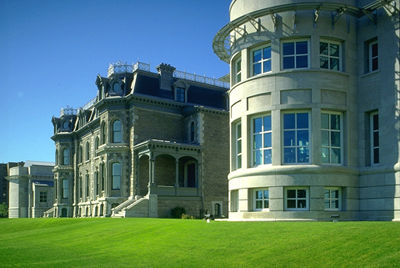Browse "Buildings & Monuments"
-
Article
24 Sussex Drive
24 Sussex Drive, in Ottawa, was designated as the official residence of the prime minister of Canada in 1950 and, in 1951, Louis St-Laurent became the first prime minister to live in the house. It was designed by J.M. Currier
"https://development.thecanadianencyclopedia.ca/images/tce_placeholder.jpg?v=e9dca980c9bdb3aa11e832e7ea94f5d9" // resources/views/front/categories/view.blade.php
https://development.thecanadianencyclopedia.ca/images/tce_placeholder.jpg?v=e9dca980c9bdb3aa11e832e7ea94f5d9
-
Article
Alberta Jubilee Auditoriums
Alberta Jubilee Auditoriums, Northern (Edmonton) and Southern (Calgary). Built between 1955 and 1957 as a memorial to Alberta's pioneers.
"https://development.thecanadianencyclopedia.ca/images/tce_placeholder.jpg?v=e9dca980c9bdb3aa11e832e7ea94f5d9" // resources/views/front/categories/view.blade.php
https://development.thecanadianencyclopedia.ca/images/tce_placeholder.jpg?v=e9dca980c9bdb3aa11e832e7ea94f5d9
-
Article
Balmoral Grist Mill
Balmoral Grist Mill in Balmoral Mills, NS, was built in about 1874 by Alexander MacKay. The mill is located on Matheson's Brook and was once just one of 5 mills on the brook. It was used to grind local stocks of wheat, oats, barley, rye and buckwheat to produce flour and oatmeal.
"https://development.thecanadianencyclopedia.ca/images/tce_placeholder.jpg?v=e9dca980c9bdb3aa11e832e7ea94f5d9" // resources/views/front/categories/view.blade.php
https://development.thecanadianencyclopedia.ca/images/tce_placeholder.jpg?v=e9dca980c9bdb3aa11e832e7ea94f5d9
-
Article
Banff Springs Hotel
Fairmont Banff Springs (formerly Banff Springs Hotel) is a luxury hotel located in Banff National Park. (See also National Parks in Canada; Alberta.) This famous Canadian building is an excellent example of a resort hotel. It is known for its architectural design within a natural setting (the Rocky Mountains) as well as its ability to support a thriving sports and leisure culture. The hotel was developed as part of the Canadian Pacific Railway’s network of hotels, which were constructed across Canada in order to encourage the use of its transcontinental lines. Known as the “Castle in the Rockies,” the architecture of the Fairmont Banff Springs is predominantly in the Scottish Baronial style, featuring an Arts-and-Crafts interior.
"https://d2ttikhf7xbzbs.cloudfront.net/banffspringshotel/banffspringshotel.jpg" // resources/views/front/categories/view.blade.php
https://d2ttikhf7xbzbs.cloudfront.net/banffspringshotel/banffspringshotel.jpg
-
Article
Barns
Barns, like certain of our native birds and animals, have joined the ranks of "endangered species." No funds from wealthy societies, heritage trusts or governments are spent on the purchase and preservation of our oldest barns, and their demise can be expected.
"https://d2ttikhf7xbzbs.cloudfront.net/media/media/3aa26d95-7ea8-4a62-b55e-dee5d5678e87.jpg" // resources/views/front/categories/view.blade.php
https://d2ttikhf7xbzbs.cloudfront.net/media/media/3aa26d95-7ea8-4a62-b55e-dee5d5678e87.jpg
-
Article
Basilica of St John the Baptist
Visible from everywhere in St. John's, Newfoundland, and, so important in the 19th century, the most striking building as one entered the harbour, the Basilica of St. John the Baptist was built to assert the place and power of Newfoundland's Irish Catholic population.
"https://d2ttikhf7xbzbs.cloudfront.net/media/media/8f1efec9-7456-49a4-9ba3-31a5ffc330a4.jpg" // resources/views/front/categories/view.blade.php
https://d2ttikhf7xbzbs.cloudfront.net/media/media/8f1efec9-7456-49a4-9ba3-31a5ffc330a4.jpg
-
Article
Brock's Monument, Queenston Heights
The monument to Sir Isaac Brock stands atop Ontario’s Niagara Escarpment at Queenston Heights, overlooking the lower Niagara River. The current monument is the second erected in Canada to honour Brock, a military commander who died during the Battle of Queenston Heights in the War of 1812.
"https://d2ttikhf7xbzbs.cloudfront.net/media/media/da5bc151-a17e-4794-9d5d-fd6eb47e06f9.jpg" // resources/views/front/categories/view.blade.php
https://d2ttikhf7xbzbs.cloudfront.net/media/media/da5bc151-a17e-4794-9d5d-fd6eb47e06f9.jpg
-
Article
Canada House
Canada House, a distinctive symbol of Canadian interests in Britain, located in London's bustling Trafalgar Square.
"https://d2ttikhf7xbzbs.cloudfront.net/media/media/eace665f-b462-4eb7-b033-fa64d5bda978.jpg" // resources/views/front/categories/view.blade.php
https://d2ttikhf7xbzbs.cloudfront.net/media/media/eace665f-b462-4eb7-b033-fa64d5bda978.jpg
-
Article
Canadian Broadcasting Centre
The Canadian Broadcasting Centre was developed as the result of a proposal call process in which the Cadillac Fairview Corporation Limited was selected to develop the 9.3 acre site, owned by the CBC, and build the centre, which was then leased to the CBC on a long-term basis.
"https://development.thecanadianencyclopedia.ca/images/tce_placeholder.jpg?v=e9dca980c9bdb3aa11e832e7ea94f5d9" // resources/views/front/categories/view.blade.php
https://development.thecanadianencyclopedia.ca/images/tce_placeholder.jpg?v=e9dca980c9bdb3aa11e832e7ea94f5d9
-
Article
Canadian Centre for Architecture
The Canadian Centre for Architecture (CCA) is both a museum of architecture and a research institute. It is located in Shaughnessy Village, a neighbourhood in downtown Montreal. Internationally renowned, the CCA is the primary Canadian institute devoted to the study of architecture. It was founded in 1979 by architect Phyllis Lambert to raise public awareness of the importance of architecture in society and to encourage innovation and university research regarding architecture.
"https://d2ttikhf7xbzbs.cloudfront.net/media/media/cccea479-6a06-49cb-9370-1aec65839121.jpg" // resources/views/front/categories/view.blade.php
https://d2ttikhf7xbzbs.cloudfront.net/media/media/cccea479-6a06-49cb-9370-1aec65839121.jpg
-
Article
Canadian Music Hall of Fame
The Canadian Music Hall of Fame was established in 1978 by the Canadian Academy of Recording Arts and Sciences (CARAS). It honours individuals or groups that have made an outstanding contribution to the international recognition of Canadian artists and music. For many years, a sole inductee was presented annually at the Juno Awards. Since 2019, multiple inductees have also been presented annually at a separate ceremony at the National Music Centre in Calgary.
"https://d2ttikhf7xbzbs.cloudfront.net/media/new_article_images/NationalMusicCentre/26137577257_571cc8e1b1_z.jpg" // resources/views/front/categories/view.blade.php
https://d2ttikhf7xbzbs.cloudfront.net/media/new_article_images/NationalMusicCentre/26137577257_571cc8e1b1_z.jpg
-
Article
Canadian War Museum
The Canadian War Museum, Canada's national museum of military history, was opened in 2005 on the south bank of the Ottawa River. The museum, originally begun in 1880 as an informal collection of military artifacts, was moved in 1967 to an archives building on Sussex Drive with most of the collection stored off-site. In 2001, the Federal Government announced the decision to fund the construction of a state-of-the art new building to be situated in the LeBreton Flats area of downtown Ottawa. Designed by Moriyama & Teshima Architects in a joint venture with Griffiths Rankin Cook Architects, the Museum opened in May 2005. Appropriately, its opening coincided with the 60th anniversary of the end of World War II in Europe and also the 125th anniversary of the museum itself.
"https://d2ttikhf7xbzbs.cloudfront.net/media/media/1cd591e9-f99b-48ed-8934-7b6ed5602bd9.jpg" // resources/views/front/categories/view.blade.php
https://d2ttikhf7xbzbs.cloudfront.net/media/media/1cd591e9-f99b-48ed-8934-7b6ed5602bd9.jpg
-
Article
Notre-Dame de Québec Cathedral-Basilica
Notre-Dame de Québec is a cathedral-basilica with primatial status, being the mother church of a primate of the Catholic Church in Canada, in this case the Archbishop of Québec.
"https://d2ttikhf7xbzbs.cloudfront.net/media/media/6a73eb44-33c1-41c9-9e6f-4d4f853b2e7e.jpg" // resources/views/front/categories/view.blade.php
https://d2ttikhf7xbzbs.cloudfront.net/media/media/6a73eb44-33c1-41c9-9e6f-4d4f853b2e7e.jpg
-
Article
Chan Centre for the Performing Arts
Chan Centre for the Performing Arts. Performing arts complex at the University of British Columbia (UBC) campus, Vancouver.
"https://d2ttikhf7xbzbs.cloudfront.net/media/media/4e3fc0b1-144c-4b0f-b2d3-a51357a27ce8.jpg" // resources/views/front/categories/view.blade.php
https://d2ttikhf7xbzbs.cloudfront.net/media/media/4e3fc0b1-144c-4b0f-b2d3-a51357a27ce8.jpg
-
Article
Château Frontenac
Built by Canadian Pacific beginning in 1892, and designed by architect Bruce Price, the Château Frontenac is an excellent example of château-style hotels developed by railway companies in Canada.
"https://d2ttikhf7xbzbs.cloudfront.net/media/media/7d924fcf-8eec-4819-8503-5b8f85bbd7cb.jpg" // resources/views/front/categories/view.blade.php
https://d2ttikhf7xbzbs.cloudfront.net/media/media/7d924fcf-8eec-4819-8503-5b8f85bbd7cb.jpg
